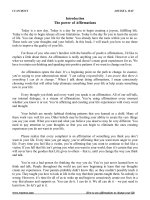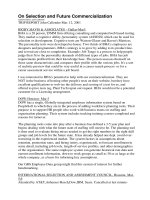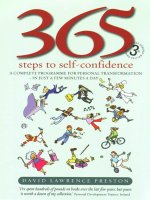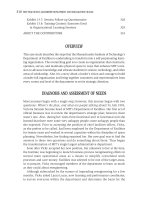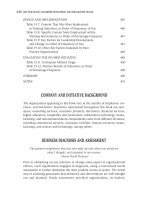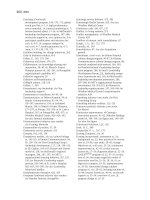Notes on Influencer to Change Anything_7 pdf
Bạn đang xem bản rút gọn của tài liệu. Xem và tải ngay bản đầy đủ của tài liệu tại đây (754.37 KB, 21 trang )
137
6
Harness Peer Pressure
SOCIAL MOTIVATION
I was part of that strange race of people aptly
described as spending their lives doing things
they detest to make money they don’t want to buy
things they don’t need to impress people they dislike.
—Emile Henry Gauvreau
Design
Rewards and
Demand
Accountability
Change the
Environment
Harness
Peer Pressure
Find Strength
in Numbers
Make the
Undesirable
Desirable
Surpass
Your Limits
MOTIVATION
PERSONAL
SOCIAL
STRUCTURAL
ABILITY
Copyright © 2008 by VitalSmarts, LLC. Click here for terms of use.
138 INFLUENCER
W
hen seeking influence tools that have an impact on
profound and persistent problems, no resource is
more powerful and accessible than the persuasion
of the people who make up our social networks. The ridicule
and praise, acceptance and rejection, approval and disapproval
of our fellow beings can do more to assist or destroy our change
efforts than almost any other source. Smart influencers appre-
ciate the amazing power humans hold over one another, and
instead of denying it, lamenting it, or attacking it, influencers
embrace and enlist it.
THE POWER
In 1961, when psychologist Stanley Milgram set out to find U.S.
citizens similar in disposition to what society believed were the
crazy misfits, blind fundamentalists, and psychological wrecks
who had marched Jews, Poles, and Romanies into the gas cham-
bers at Auschwitz, the world was surprised by what he discovered.
In fact, Dr. Milgram’s findings were so disturbing that he fell
under attack from every corner. Nobody wanted to believe the
data.
Mystified by what had happened in Hitler’s Germany, Dr.
Milgram was interested in what type of person could be com-
pelled to annihilate his or her innocent friends and neighbors.
Naturally, blind fundamentalists who followed unspeakable
orders all in the name of political zealotry would be hard to
locate in the suburbs of Connecticut. Nevertheless, Milgram
was determined to track down a few of them and put them
under his microscope.
Of course, as a respectable researcher, Milgram couldn’t
create circumstances under which his neighbors actually killed
each other. But maybe he could trick subjects into thinking
they were killing someone else, when in truth their victims
would remain unharmed. To create these odd circumstances,
Dr. Milgram ran an ad in the New Haven newspaper asking
Harness Peer Pressure 139
people to take part in an experiment that lasted one hour and
for which they would be paid $4.50. Interested persons reported
to the basement of Linsly-Chittenden Hall on the campus of
Yale University where they were told that their job would be to
take part in a study that examined the impact of negative rein-
forcement on learning.
While waiting for their turn to earn $4.50, subjects would
chat with another participant about the upcoming job. This
friendly stranger was actually a confederate of Dr. Milgram’s
who was working as part of the research team. Next, a scientist
in a lab jacket would appear and ask each of the two subjects
to reach into an urn and draw out a slip of paper to determine
who would perform which of the two jobs that were available.
One would be a “teacher,” and one would be a “learner.” In
actuality, both slips said “teacher,” guaranteeing that the actual
research subject would take the role of the teacher.
The teacher would then accompany the learner and the
researcher into a small booth where the learner was invited to
sit down while the researcher applied special paste to his arms.
“This,” he explained, “is to ensure solid contact between your
skin and the electrodes when we administer the shocks.” At this
point, the learner would matter-of-factly explain, “A few years
ago in the veterans’ hospital I was told I had a bit of a heart
condition. Will that be a problem?” To which the researcher
would confidently say, “No. While the shocks may be painful,
they are not dangerous.”
After strapping the electrodes to the learner, the researcher
and teacher would close the booth door and move to the
adjoining room. There the teacher would see a frightening
piece of electrical machinery with which he or she would
deliver shocks to the learner. To reassure subjects that the
machine was pumping out real electrons, each “teacher” would
be given a 45-volt burst from the machine as a sample of the
initial shock the learner in the other room would receive dur-
ing the experiment. It hurt.
140 INFLUENCER
The stated goal of the experiment was to measure the
impact of negative reinforcement on learning. To test this,
the teacher would read a list of paired words loud enough for
the learner to hear in the adjoining room. The subject would
then read the first word in each pair, and the learner would try
to recall the second word. Should the learner get the word
wrong, the subject would throw a switch that would shock the
poor learner with the heart problems. With each subsequent
missed word, the teacher would raise the voltage, flip the
switch, and give the learner an even larger shock.
Despite the fact that the subject thought he was increasing
the voltage with each new error, the “learner” received no elec-
tric shock whatsoever. Instead, with each throwing of the
switch, the researchers would play prerecorded audio that the
subject could hear through the wall. With the first shock came
a grunt. The second shock produced a mild protest. Next,
stronger protests. Then screaming and shouting. Then scream-
ing and banging on the wall with a reminder that he had heart
problems. Eventually, when the voltage levels exceeded 315
volts, the subject would hear nothing but silence as he read the
words, raised the voltage, and cruelly flipped the switch.
Of course, Dr. Milgram knew he would have to experiment
with a lot of subjects before he’d find anyone who would keep
cranking up the volts. In fact, when Milgram asked a sample
group of social psychologists to predict the results of this chill-
ing study, they suggested that only 1.2 percent of the popula-
tion, only a “sadistic few,” would give the maximum voltage.
When you watch black-and-white film clips of Milgram’s
actual subjects taking part in the study, the hair stands up on
the back of your neck. At first these everyday folks off the streets
of Connecticut chuckle nervously as they hear the learner
grunt in protest after being given a 45-volt shock. Some show
signs of stress as they increase the voltage and the learner starts
to shout. Many pause at around 135 volts and question the pur-
pose of the experiment.
Harness Peer Pressure 141
If at any time the subject called for a halt, he was told by
the scientist in the white lab jacket that the experiment required
him to continue—up to four times. If the subject requested to
stop a fifth time, the experiment stopped. Otherwise the exper-
iment came to an end only after the subject had given the max-
imum 450 volts—to a learner who was no longer protesting, but
who had gone completely silent—giving the teacher the dis-
tinct impression that the learner had either passed out or died.
Clearly the subjects who continued to send more and
more volts to their protesting, screaming, and begging cohort
took no pleasure in what they were doing. It’s unnerving to
watch clips as anguished subjects suggest that they should stop
the torture. After offering their suggestion, they are immediately
told that the experiment calls for them to continue.
Researchers watched and recorded the subjects, taking
comfort in knowing that only a few subjects would administer
much of a shock. As it turned out, “only” 65 percent of sub-
jects would.
That’s the finding that got Milgram in trouble. He hadn’t
discovered a tiny handful of Connecticut zealots and sociopaths
who would gladly give their souls over to the totalitarian cause.
He had found the vulnerable target within all of us. He had
looked for the freak and found himself—and you and me. And
nobody liked it.
What was going on? Why do human beings place such a
high premium on the approval of others—often strangers?
Certainly that’s what you’d ask if you were a social scientist. If
you were a student of influence, you’d ask how this amazing
social force might work either for or against you as you do your
best to orchestrate change. You’d want to co-opt the awesome
power of social pressure for your own purposes.
Savvy people know how to tap into this enormous source
of influence in hundreds of different ways. They do so by fol-
lowing one simple principle. They ensure that people feel
praised, emotionally supported, and encouraged by those
142 INFLUENCER
around them—every time they enact vital behaviors. Similarly,
they take steps to ensure that people feel discouraged or even
socially sanctioned when choosing unhealthy behaviors.
The actual methods that influence masters use to exploit
the enormous power of “the fellow in the lab jacket” deserve
a much closer look. Whole literatures are built upon the foun-
dation of social influence. Topics ranging from leadership to
interpersonal influence to group dynamics draw from this
same source of social power.
This being the case, we take care to narrow our search by
first examining how social support can be harnessed for good.
Then we look at three best practices that help magnify the
power of social support. First, we explore how to make use of
that unique group of people who routinely exert more influ-
ence than anyone else—the much-vaunted opinion leaders.
Next, we examine how influence geniuses routinely assail not
people per se, but their shared norms. We’ll see how brilliant
leaders directly attack norms that would otherwise impede vital
behaviors. Finally, we look at what it takes to create an entire
culture of social support.
THE POWER OF ONE
Stanley Milgram clearly demonstrated that one respected indi-
vidual can create conditions that compel ordinary citizens to
act in curious, if not unhealthy, ways. But he also found the
opposite to be true. After discovering that he could propel peo-
ple to act against their own consciences, he began exploring
which variable had the largest impact on compliance. Was it
the size of the room, the look and feel of the electronic
machine, or the distance to the subject? After conducting tests
with over a thousand subjects of every ilk and under every imag-
inable condition, Milgram concluded that one variable more
than any other affected how people behaved: the presence of
one more person.
Harness Peer Pressure 143
Dr. Milgram learned that if a confederate either shocked
the person all the way to 450 volts or stood up to the authority
figure, it dramatically affected how the research subjects acted.
He could increase the already stunning 65 percent of all-the-
wayers to 90 percent if only one other person (a confederate)
gave a full dose of power just before the subject had a turn at
the machine. Equally important, he discovered that the num-
ber who would administer the full shock dropped to a mere 10
percent if one person before him or her refused to do so. Either
way, it just took one person to turn the tide of compliance.
This finding paints a much brighter picture of humanity
and offers us a wonderful influence tool. To harness the
immense power of social support, sometimes you need to find
only one respected individual who will fly in the face of his-
tory and model the new and healthier vital behaviors.
Here’s how this works. We (the authors) once watched the
power of stepping out against the norm at a large defense con-
tracting firm. At this company the CEO was trying to transform
a rather timid culture into one where individuals openly stated
their differing opinions as a means of resolving long-standing
problems. After months of lecturing, he faced a moment of
truth. In a meeting of his top 200 managers, the CEO extended
an invitation. “I’ve been told that I’m unapproachable,” he
began. “I am trying to work on it. But to be honest, I don’t know
what it means entirely. I’d appreciate feedback from any of you
who would be willing to help me.”
For a few seconds, the auditorium felt like a morgue. As the
CEO scanned the audience for any takers, he was about
to break the awkward silence and move on when a fellow by
the name of Ken raised his hand. “Sure, Bill. I’ve got some
suggestions.”
With that announcement, the CEO set an appointment to
talk one-on-one with Ken. As you might guess, from that
moment on most of the water-cooler chatter was about the fool-
ish risk Ken had just taken. Pay-per-view could have made a
144 INFLUENCER
fortune selling access to the private meeting between Ken and
the CEO. But in the end, the entire story came out—from the
CEO.
After meeting with Ken, the CEO sent out an e-mail de-
tailing the feedback he’d gotten. He made commitments to a
couple of changes that he hoped would make him more ap-
proachable, and he was as good as his word. Equally important,
the CEO sincerely thanked Ken for his candor. The CEO
showed his genuine support of the behavior of being candid by
not becoming defensive and by rewarding the person who had
taken the risk to be honest—even when it hurt—and he then
made personal changes to demonstrate his commitment.
The results were far-reaching. The CEO’s and Ken’s living
examples of seeking and giving feedback emboldened the
other 199 managers. Within months candor among employees
increased dramatically across the entire organization. Em-
ployees began to open up and successfully solve problems.
Although it’s true that neither Ken nor the CEO wore white
lab jackets, they did exert social influence. Both were respected
individuals, and both demonstrated how to break from tradition
and speak frankly. Had the CEO only given lip service to the
proposed vital behavior, he would have doomed the change
effort. Had he simply used verbal persuasion, his influence
would have been equally limited. Instead, the big boss encour-
aged candor, embraced it, celebrated it, and rewarded the first
person who had the guts to speak his mind.
When a respected individual attempts a vital behavior and
succeeds, this one act alone can go further in motivating
others to change than almost any other source of influence. But
take note, the living examples of other humans exert power
only to the extent that the person who is modeling the vital
behaviors is truly respected. For example, when an HR man-
ager at a midsized plywood mill we (the authors) consulted with
tried to put teeth into a training program she was touting, she
videotaped the president of the company singing the praises of
Harness Peer Pressure 145
the new training. The president ended his short, energetic
speech with, “I encourage each of you to take to heart the con-
cepts taught in today’s training.”
When the HR manager showed the video clip at the begin-
ning of the first training session, participants jeered, hooted, and
mocked the president. It turns out that members of the audi-
ence despised anything coming out of headquarters. They
thought the president was a raging hypocrite, and his ringing
endorsement only served to harm the training’s credibility.
Some individuals can exert a great deal of influence on one
another; others can’t. So how do you know who’s who?
THE POWER OF
THE RIGHT
ONE
We’ve seen that one person can have an enormous effect on
motivating others to enact vital behaviors. We’ve also seen that
the influence of formal leaders (like the CEO and the guy in
the white lab coat) can have a remarkable influence on the
behavior of those in their sphere of influence. So if you want
to influence change, it’s essential that you engage the chain of
command. Smart influencers spend a disproportionate amount
of time with formal leaders to ensure that the leaders are using
their social influence to encourage vital behaviors.
But the bosses are only half of what you’ll need. It turns out
that there’s a second and often overlooked group of people
whose social support or resistance will make or break your influ-
ence efforts. To find out who this group is and how to enlist it,
let’s take a look at the work of Dr. Everett Rogers. His contri-
bution to influence theory remains one of the greatest in his-
tory and has important implications to how all parents, coaches,
and leaders can best make use of social support.
After graduating with a Ph.D. in sociology and statistics, Dr.
Rogers took an intriguing job with the local university exten-
sion service. It was his responsibility to encourage Iowa farm-
ers to use new and improved strains of corn. What could be
146 INFLUENCER
easier? The new strains of corn Rogers was touting produced
greater yields and were dramatically more disease resistant, and
therefore, far more profitable than current strains.
As Dr. Rogers talked with local farmers about the terrific
new seeds he was recommending, he quickly learned that his
education and connection to the university didn’t impress
them. He wasn’t exactly one of them. Farmers dressed differ-
ently; their hands were rough from physical labor; they read dif-
ferent magazines and watched different TV programs. Other
than speaking the English language, they scarcely had a thing
in common with Rogers.
At first, Dr. Rogers figured that this difference would actu-
ally work to his advantage. The reason the farmers should lis-
ten to his advice was because he hadn’t done what they had
done. He had made a careful study of the crops they should
grow. He was now working for the experts in agronomy. In fact,
Rogers figured that when he talked, farmers would be taking
notes and thanking him for helping them increase their yields.
But it didn’t work that way. It turns out that Rogers wasn’t
just different. In the farmers’ view, he was the wrong kind of dif-
ferent. He was naive. He was a city slicker. He had never plowed
a field. Sure, he said he read books, but what if he was wrong?
Who would dare put their annual harvest at risk by listening to
a young fellow just out of college? None of the farmers. That’s
who.
After being summarily rejected by his target population,
Rogers grew increasingly confused and desperate. What good
is it, Rogers wondered, to invent better methods—in fact, far
better methods—if no one will put them into practice? The
very advance of civilization relies on citizens letting go of old,
inefficient ways and embracing new, efficient ones. And Rogers
just happened to know what those better ways were—at least
for the farmers.
What could Dr. Rogers do if people didn’t respect him
(which they most certainly didn’t)? The very fact that he was
Harness Peer Pressure 147
the one suggesting the new idea prevented people from listen-
ing to it. Perhaps Dr. Rogers could get a farmer to embrace the
new strains of corn. Then a person from within the farming
community could point to the better results, and everyone
would be jumping on the bandwagon. If Dr. Rogers could find
a person who would be interested in trying the latest strains,
he would be halfway home.
Eventually he enticed a farmer into giving the most current
strains of corn a try. He wasn’t much like the other farmers. He
was a rather hip fellow who actually wore Bermuda shorts and
drove a Cadillac. He had a proclivity for embracing innovation,
so he tried the new strains of corn and enjoyed a bumper crop.
Now his neighbors would see the better results and be moti-
vated to change.
Only they weren’t.
The farmers didn’t adopt the new corn because they didn’t
like the weirdo in Bermuda shorts who spurned their lifestyle
any more than they liked the pretentious academic who had the
nerve to tell them what to do.
This unvarnished failure changed the course of Rogers’s
life. He spent the rest of his career learning what happens to
innovations as they move through a social system. He wanted
to learn why some ideas are adopted and others aren’t. He also
wanted to uncover why certain individuals are far more influ-
ential in encouraging people to embrace an innovation than
others.
As Rogers set to work, he examined every known study of
change. He reviewed how new drugs catch on among doctors.
He looked at how new technologies, such as VCRs, become
popular. He studied the latest gadgets and discoveries. As he
pored over the data, he was startled at how many great ideas
simply die. For example, when Vasco de Gama made his tri-
umphant voyage around the Cape of Good Hope, he took 160
men with him. Only 60 returned because the rest died of
scurvy. Fortunately, in 1601, an English sea captain named
148 INFLUENCER
John Lancaster discovered a cure for scurvy. He gave a little bit
of lime juice to his sailors every day, and no one died of scurvy.
And yet it took almost 200 years for the practice to catch on.
Initially the British were actually mocked for their curious prac-
tice, and the derisive term limey was born.
Rogers was shocked to discover that the merit of an idea did
not predict its adoption rate. What predicted whether an inno-
vation was widely accepted or not was whether a specific group
of people embraced it. Period. Rogers learned that the first
people to latch onto a new idea are unlike the masses in many
ways. He called these people innovators. They’re the guys and
gals in the Bermuda shorts. They tend to be open to new ideas
and smarter than average. But here’s the important point. The
key to getting the majority of any population to adopt a vital
behavior is to find out who these innovators are and avoid
them like the plague. If they embrace your new idea, it will
surely die.
The second group to try an innovation is made up of what
Rogers termed “early adopters.” Many early adopters are what
are commonly known as opinion leaders. These important peo-
ple represent about 13.5 percent of the population. They are
smarter than average, and tend to be open to new ideas. But
they are different from innovators in one critical respect: They
are socially connected and respected. And here’s the real influ-
ence key. The rest of the population—over 85 percent—will
not adopt the new practices until opinion leaders do.
So it turns out that when the fellow with the Bermuda
shorts used the new seeds, he didn’t do Rogers a favor. As far
as farming methods were concerned, Cadillac man was an
innovator. He was the first to adopt new ideas in his commu-
nity, and like many innovators, he cast suspicion on the “new
ways” he endorsed. Since he was different from the majority of
his peers in visible ways, and since much of what he did ap-
peared to disrespect traditional methods, this made him a
threat. He was neither respected nor connected.
Harness Peer Pressure 149
As Rogers later explained, he learned that his recommen-
dations would have fared better if he had carefully sought out
opinion leaders to tout his strains of corn.
Given the boost opinion leaders can offer an influence strat-
egy, it is no surprise to learn that the influencers we studied rou-
tinely use this powerful source of influence. For example, when
Dr. Don Berwick and IHI try to influence the behavior of hun-
dreds of thousands of physicians across the United States, they
first engage the guilds, as they call them. These are the associa-
tions and research groups other physicians look to as credible
sources. When the guilds talk, physicians listen.
Similarly, when Dr. Howard Markman tries to influence
the communication behavior of couples across the country, he
also looks for opinion leaders. He has found that if he trains
members of the clergy to teach couples how to solve problems,
the results are better than if an unknown outsider in Bermuda
shorts swoops into town and offers training.
And how about the Guinea worm disease? Donald Hopkins
and his team don’t consider going into a village without first
working with the village chief or drawing on the power of a
respected official. From there, the local official or chief iden-
tifies respected village members from different groups or clans
who will be listened to when they teach people the vital behav-
iors required to eradicate the Guinea worm disease. Imagine
what would happen if Hopkins recruited a person of no social
standing to carry a lifesaving message that challenges old
beliefs and norms. Such a person would probably be dis-
counted in a heartbeat.
“The message,” Hopkins reports, “is no more important
than the messenger.”
Interestingly, the power of opinion leaders is available even
when you don’t have real opinion leaders. The TV and radio
heroes we referred to earlier become opinion leaders. For exam-
ple, in the village of Lutsaan, India, a community action group
made a solemn covenant to educate their daughters after lis-
150 INFLUENCER
tening to the wildly popular show Tinka, Tinka Sukh (“Hap-
piness Lies in Small Things”). In this poignant TV drama, a
beloved young girl dies in childbirth after being forced into an
early marriage. After vicariously experiencing her death, audi-
ence members wrote over 150,000 letters in reaction to the
episode. Listeners were so affected by what happened to the
young girl that 184 Lutsaan villagers placed their thumbprints
on a large public poster in honor of their fallen heroine in a
gesture of solidarity and support.
“Of course I will not marry off my daughter before she turns
18,” one listener told Dr. Arvind Singhal, who was commis-
sioned to study the effects of the serial drama. “Prior to listen-
ing to Tinka, Tinka Sukh, I had it in my mind that I need to
marry off my daughter soon. Now I won’t, and I tell others
as well.”
Since Tinka, Tinka Sukh always featured an epilogue dur-
ing which a respected person from the community asked ques-
tions, made a call to action, and encouraged public discourse,
the show made double use of opinion leaders. The comments
from the respected figure combined with the actions of the
beloved characters made excellent use of social support as a
means of promoting change.
To see how to work with opinion leaders, independent of
other influence strategies, let’s take a look at what Mao Zedong
did some 40 years ago. A terrible human being in most respects,
Mao understood a thing or two about leveraging social influ-
ence to accomplish a bit of good.
On June 26, 1965, Mao lit a fire under the Chinese Min-
istry of Health, citing its poor record in improving health prac-
tices in the far-flung rural regions of China. Rather than wait
for the stodgy ministry and medical institutions to solve the
problem, Chairman Mao engaged 1.8 million change agents
in the cause.
When deciding who would make up his population of
change agents, he didn’t go with existing health specialists.
Harness Peer Pressure 151
Instead, Mao zeroed in on locals who came from the villages
they were to serve, who were recommended by their peers, who
were committed to serve the people, and who had a basic level
of formal schooling, which put them close to their fellow vil-
lagers but slightly above them in education. In short, Mao
chose opinion leaders.
These “barefoot doctors,” as they were later called, were
given just a few months of medical training that covered basic
preventive practices that could quickly and significantly improve
public health in rural areas. They also learned how to treat the
most common maladies. And to reduce risk, they were taught
to refer more difficult cases to commune hospitals.
The results were immediate and dramatic. Health-related
habits in rural villages improved overnight. Villagers adopted
practices such as observing basic hygiene and boiling water;
and they adopted these practices much faster than predicted.
Mao broke from his traditional methods and didn’t issue uni-
lateral commands or create harsh policies because he knew
they wouldn’t have had much effect in rural China. Instead,
he coupled support from the top with the actions of on-the-
ground opinion leaders.
ENLIST SOCIAL SUPPORT
Rogers’s discovery offers enormous leverage to leaders, parents,
and the general population alike. When it comes to creating
change, you no longer have to worry about influencing every-
one at once. If you preside over a company with 10,000
employees, your job is to find the 500 or so opinion leaders who
are the key to everyone else. Spend disproportionate time with
them. Listen to their concerns. Build trust with them. Be open
to their ideas. Rely on them to share your ideas, and you’ll gain
a source of influence unlike any other.
You don’t get to decide whether or not you engage the help
of opinion leaders. By definition, they will always be engaged.
152 INFLUENCER
They always observe and judge your influence strategy—that’s
what they do. Then they will give your ideas either a thumbs-
up or a thumbs-down. And since they’re respected and con-
nected, they will exert their widely felt influence and decide the
destiny of your influence strategy—whether you like it or not.
If you’re interested in engaging opinion leaders in your own
change efforts, the good news is that finding them is quite easy.
Since opinion leaders are employees who are most admired
and connected to others in the organization, simply ask peo-
ple to make a list of the employees who they believe are the
most influential and respected. Then gather the lists and iden-
tify those who are named most frequently (typically ten or more
times). These are the opinion leaders. Once you know who
they are, enlist them and partner with them in your efforts to
institute change.
Enlist Social Support to Influence
You
On a more personal note, if you’re trying to change something
within your own life, co-opt the power of those who have an
influence on you. If it’s true that we’ll electrocute a stranger
because a guy in a lab coat says, “The experiment requires that
you continue,” what could we get ourselves to do if we could
only find a way to marshal the social support of our actual loved
ones and friends?
It turns out, quite a lot. For instance, research demonstrates
that those who simply receive e-mails from a friend checking
on their progress with smoking cessation, dieting, or exercise
do a much better job of sticking with their plans than those who
receive no inquiries. (This means that our friend Henry needs
to enlist the emotional support and encouragement of his
wife, coworkers, and loved ones if he expects to live a healthy
lifestyle.) When diabetics involve a loved one in their disease
maintenance, compliance soars. Social psychologists learned
long ago that if you make a commitment and then share it with
Harness Peer Pressure 153
friends, you’re far more likely to follow through than if you sim-
ply make your commitment to yourself.
Better still, team up with someone who is attempting to
make the same changes you are. Exercise together. Diet
together. Work on your explosive tempers together. Encourage
each other, keep each other in the loop, and hold each other
accountable. We crave the acceptance and admiration of those
we admire. So co-opt the power of social support for your own
benefit.
Become an Opinion Leader Yourself
If you aspire to become an effective influencer, you should also
aspire to become an opinion leader within your own work and
family circle. Parents, in particular, do well when they remain
a respected voice with their children throughout the develop-
mental years, and not just until their kids turn 13. Despite the
stereotype of all teenagers eventually dismissing their parents’
opinions, there are many parents who remain an important
source of influence, even during their children’s most trying
years. This doesn’t mean that their offspring eagerly embrace
every parental opinion or admonition, but that their parents’
opinions still carry weight, even when they go against the
wishes of their children.
Here’s what it takes to become and remain an opinion
leader. People, including children, pay attention to individuals
who possess two important qualities. First, these people are
viewed as knowledgeable about the issue at hand. They tend to
stay connected to their area of expertise, often through a variety
of sources. Second, opinion leaders are viewed as trustworthy.
They don’t merely know a great deal about a certain area, but
they also have other people’s best interest in mind. This means
that they aren’t seen as using their knowledge to manipulate or
harm, but rather to help. If others believe that you’re missing
either of these two qualities, you won’t be very influential.
154 INFLUENCER
But being respected and trusted isn’t enough. Opinion lead-
ers are also generous with their time. They frequently rub
shoulders with the people who look up to them, and when
doing so, they speak their minds in a direct, healthy way. For
instance, when we (the authors) examined the factors that con-
tribute to employees’ satisfaction in their relationship with
their boss, we found that the best predictor was frequency of
interaction. Long periods of absence don’t help. Bosses who are
accessible, talk openly, and spend informal time chatting
with their direct reports are far more likely to be influential
than those who maintain their distance. The same is true with
parents.
So when it comes to drawing on the power of social influ-
ence, think opinion leader. Identify opinion leaders, partner
with opinion leaders, and become an opinion leader in your
own right. If you want to be an opinion leader with your
coworkers, direct reports, friends, and family members, you
have to be both respected and connected. More often than not,
that calls for face-to-face dialogue where you jointly discuss
issues, work through differences, and come to shared agree-
ments.
THE POWER OF
EVERYONE
Occasionally the problem you’re dealing with stems from long-
held and widely shared norms. Virtually everyone has done the
same thing for years—even generations. As these norms begin
to change, everyone needs to talk about the changes before any-
one can successfully act in new ways without facing ridicule
and eventual isolation. Changes in behavior must be preceded
by changes in the public discourse.
However, openly discussing certain norms is often consid-
ered taboo or at least politically incorrect. The chances for cre-
ating change in such cases are especially dim—unless, of
course, an effective influencer finds a way to partner with opin-
Harness Peer Pressure 155
ion leaders in making the undiscussable discussable. Learn how
to transform taboo subjects into a routine part of the public dis-
course, and you possess an enormously powerful tool for deal-
ing with some of the toughest cases imaginable.
Make Undiscussables Discussable
In the early 1980s, the authors were invited to help a manage-
ment team revive a dying manufacturing plant that labored in
the very center of the industrial rust belt. The task was to
increase profits in the facility by reducing costs and increasing
productivity. This manufacturing facility posted a productivity
level significantly below that of the average offshore competi-
tor. If this embarrassing benchmark continued to drag bottom,
the place was doomed.
To find out what it would take to turn the productivity prob-
lems around, the authors met with key personnel and asked one
question: “If you could fix one thing around here, what would
it be?” The very first person we posed this question to was a
superintendent who had worked in the plant for over 20 years.
When answering the question, he leaned forward, lowered his
voice, looked around twice to see if anyone was listening in,
and stated, “All we need to do is one thing. If we could get a
good six hours a day out of our skilled labor force, we could
make a profit.”
The nervous fellow went on to explain that while it was true
that many employees were giving the job an honest effort,
many weren’t. In fact, most had developed a lifestyle that
depended on overtime pay, and, to ensure this overtime, they
had slowed down. The majority of these free-effort employees
were on the clock for an average of ten hours a day, but they
were actually working only about four. So if they could just get
six hours
We couldn’t help but notice that the superintendent
was talking to us in much the same tone and style of an FBI
156 INFLUENCER
informant. He didn’t want anyone to know he was making this
horrible indictment. People weren’t very productive, but this just
wasn’t something you said aloud. He even swore us to secrecy.
Over the next few years we interviewed hundreds more peo-
ple at the facility and surfaced dozens of other issues, but the first
fellow had it right. He was dead on when he suggested that if you
stated aloud that people weren’t working hard, it would put you
in an awkward position. People would accuse you of being bit-
ter, unfair, and insensitive. People would accuse you of being dis-
respectful of American workers. They might even threaten you.
To make matters worse, the public discourse at this
time was very different. Every voting year, politicians would
actually stand in front of cameras and brag about the American
workforce and its unparalleled work ethic. The people we
worked with would roll their eyes in disgust with each pro-
nouncement, but they wouldn’t openly disagree. Nobody could
actually say such heresies aloud. When we suggested to the lead-
ership team that the influence strategy we had in mind would
directly deal with low productivity, they told us that we had to
couch the problem in different terms: We would teach leaders
“how to hold people accountable.” So we did. Of course, when
leaders held people accountable, they only dealt with safety,
cost, and quality problems because they couldn’t talk about pro-
ductivity. This issue was still totally undiscussable.
The next year when the labor contract came up for renewal,
we begged the HR professionals who were going to sit at the
big table during negotiations to bring up the productivity issue.
They did, repeatedly, but to no avail. Eventually they were told
by the union and company leaders to drop the subject. It was
just too divisive, too volatile. They couldn’t talk about produc-
tivity anymore.
In a place where productivity was the elephant in the liv-
ing room, nobody on the change team could talk about it. So
we didn’t. We worked on dozens of different problems, teach-
ing a variety of skills, and making dozens of changes, but we
Harness Peer Pressure 157
never dealt directly with productivity. Was that a smart move?
Take a look at what has happened with the vast majority of
America’s skilled trade jobs over the past couple of decades, and
you’ll probably conclude that remaining silent about the issue
was a huge mistake.
To see what we should have done to solve the productivity
problem, let’s return to the Indian village of Lutsaan and revisit
the mechanism through which the radio drama Tinka, Tinka
Sukh affected public opinion. And although it’s true that the
villagers didn’t face a productivity challenge, they did run into
a powerful social norm that caused many of them great pain,
and their problem was also completely undiscussable.
In one of the Tinka, Tinka Sukh story lines a beloved char-
acter was not allowed an education, forced to marry young, and
died in child birth. As a result of the poignant episodes, the lis-
teners in the village of Lutsaan were propelled to find a way to
change the long-held practice of marrying young. But what
actually brought about this tremendous change in norms?
According to Dr. Arvind Singhal, the power of the show
stemmed from its ability to force an undiscussable topic into
the public discourse. Long-settled beliefs were suddenly
opened to question and discussed at every corner, workstation,
and shop—and eventually reshaped.
Before the airing of the episodes, millions of people had
placed pressure on their friends, children, and coworkers to
continue to honor the traditions of their past. This was peer
pressure at its strongest. Some people had already changed their
views on the treatment of young girls, but it was difficult for
them to share their differing views openly without falling vic-
tim to public ridicule for not honoring their past. Many peo-
ple were uncertain about the tradition and wanted to be able
to talk it through, but once again, it just wasn’t done.
Entertainment education specialists applied the power of
vicarious stories to the issue. They didn’t preach the evils of
the traditional treatment of girls because, as we all know,
